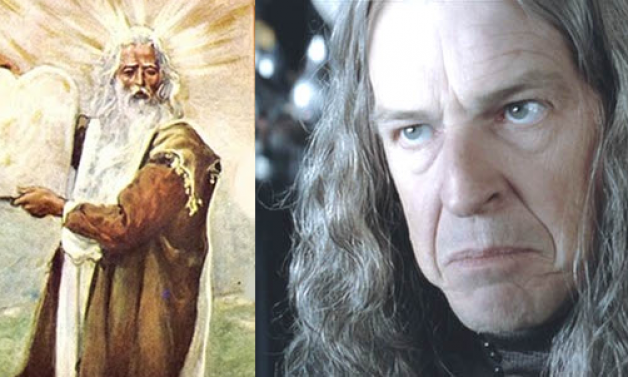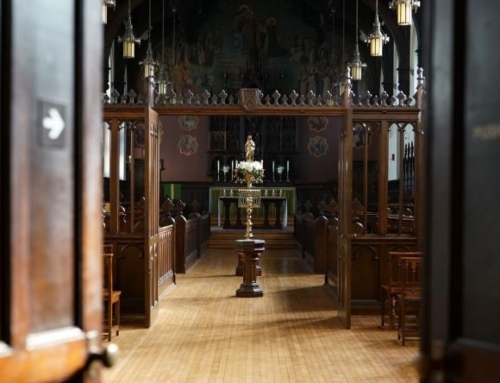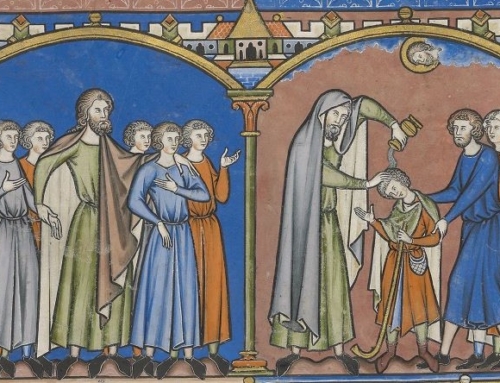Those familiar with the Lord of the Rings may be surprised at the suggestion that Denethor, the Steward of Gondor who sends his son Faramir to his certain death and attempts to burn himself along with his son because of his despair, can have something in common with Moses, the like of whom was not found among any of the other prophets of Israel (Deut 34:10). Rather than slipping into the endless debate of whether Tolkien’s masterpiece is an allegory, it is important to focus on the task at hand, which is to demonstrate the similarity between two persons. Some background information about Tolkien’s character is necessary.
Denethor assumes the Stewardship of Gondor in the year 2984 of the Third Age of Middle-earth. His wife, Finduilas, a “lady of great beauty and gentle heart,” dies four years later after she gradually “withers” in Gondor because of the growing “shadow in the east,” which fills her with “horror.” Denethor’s love for his wife is matched only by his love for the elder of his two sons, Boromir. The death of his wife proves too great an ordeal for Denethor to bear, and subsequently he becomes “more grim and silent than before.” Occupied with the imminent attack from Mordor, he spends his time alone in the White Tower with a stone known as the palantir.
The palantir is a seeing stone, meant to be used as a communication tool. Alternatively, it can be used to see events in other parts of Middle Earth. Sauron, the Dark Lord, also possesses a palantir. This communication device puts Denethor in contact with Sauron and his evil kingdom. Tolkien describes Denethor as a man of pride, “trusting in his own strength of will.” His endless grief over his wife and his incessant desire to know the enemy impel Denethor to do something that none of the Stewards or Kings have dared to do before: he peers into the stone, not just once, but he would often “wrestle in thought with the enemy.” The following is a clip of Gandalf the White visiting Denethor, whose features clearly resemble those of a tyrant in full despair, grieving his dead son Boromir as the orcs are preparing to attack Gondor.
http://www.youtube.com/watch?v=pjIf0-8QyuM
The reader may ask, “What is wrong with knowing the enemy?” The problem with gazing into the enemy is that eventually we “are transformed into the same image” as that which we gaze upon (see 2 Cor 3:18 for the salutary opposite). Although Denethor is transformed by using the palantir, which produces external visual effects to display the powers of Sauron, it is also possible to be transformed into the likeness of the enemy by conjuring mental images and thoughts that portray an aspect of the dark kingdom of the devil. Thoughts or images of this kind instil restlessness, fear, doubt and despair. Given the opportunity, the enemy will show us “only those things,” which he permits us to see, thereby convincing us of his seemingly unconquerable strength. Eventually Denethor surrenders without a fight and burns himself.
What is the antidote to this tendency that we all have? What do we do when we are confronted with a sinful mental image or thought? Gandalf, who can safely be taken as a figure of Christ, suggests that “in his days of wisdom,” Denethor would never “presume” to use the palantir, “knowing the limits of his strength.” Unfortunately his pride makes him blind to these limits, and his wisdom “fail[s]” him. Therefore, two virtues are needed to combat our tendency of peering into the realm of the Enemy: humility and wisdom. Humility keeps us from tinkering with harmful images and thoughts since we are aware of the limits of our strength, while wisdom urges us to occupy our minds with the Divine presence. Wisdom is where Moses comes in.
Like Denethor, Moses becomes similar to that upon which he gazes. But, unlike Denethor, Moses gazes upon something—Someone—very good. After the two original tablets of the Ten Commandments are destroyed, Moses goes up Mount Sinai a second time to receive a new pair of tablets. He spends “forty days and night” with God, and when he comes down the mountain, his face is “radiant,” so much so that he has to wear a “veil over his face” (Ex 34:33). Moses’ face shines because he speaks “face to face” with God, whose glory imprints itself on his face (Num 12:8).
There is a Christian version of this experience. For instance, St. John teaches us that, “when Christ appears, we will be like Him for we will see Him face to face” (1 Jn 3:2). The virtue of wisdom, lived in its Christian fullness, involves us gazing upon Wisdom Incarnate, Jesus Christ Himself. Such a virtuous vision is transformative. The virtue of wisdom helps us avert our mind’s eye from the kingdom of the devil and direct it towards God’s glory and beauty. Wisdom helps us supplant the negative images of the devil with divine beauty, by immersing ourselves in Scriptures and in prayer. God can be encountered and gazed upon through His word; he can be contacted and spoken to through prayer. These form a two-way street wherein we speak to God and hear His response, thereby embracing His presence and avoiding any contact with the devil.
✠
Image: Moses With Radiant Face; Denethor







